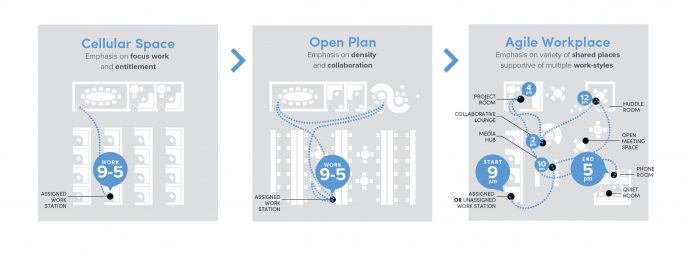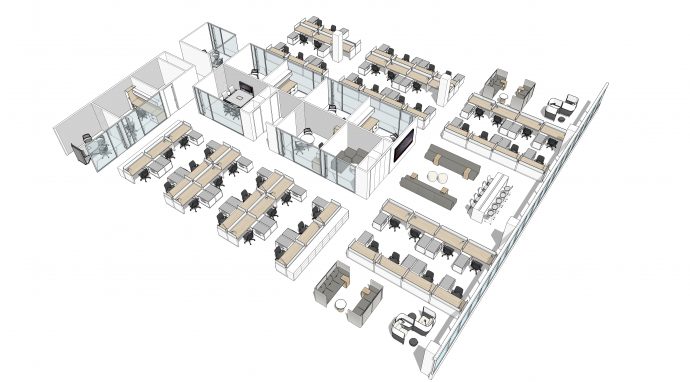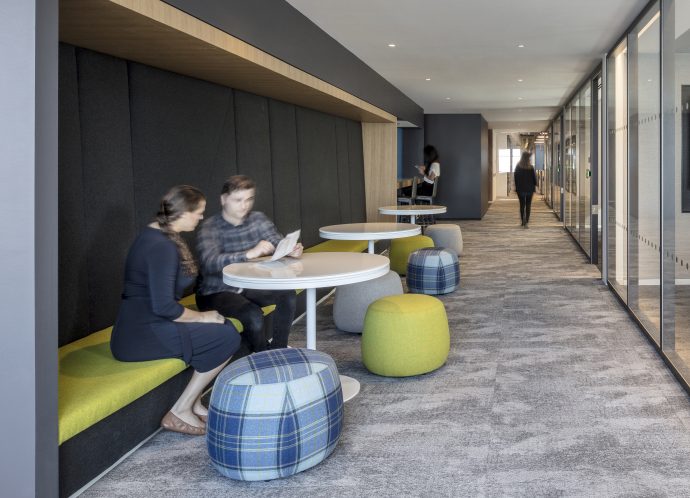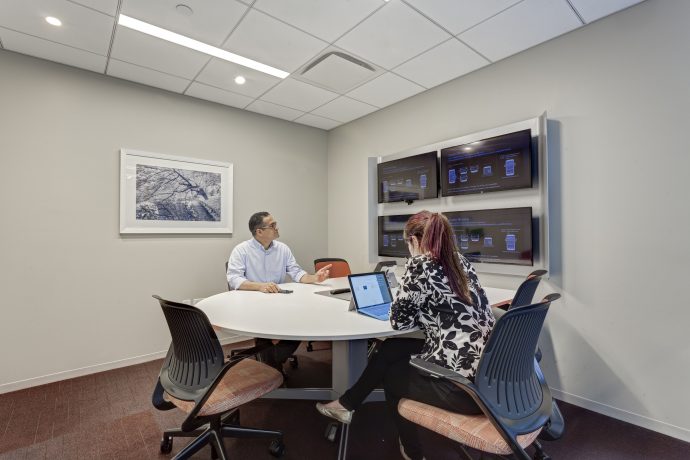Ted Moudis Associates‘ Workplace Strategist Kate Wieczorek shares her thoughts on the recent Harvard study examining the effects of the open plan.
For many, including articles discussing the recently released Harvard study which examines the effects of “open plan” on collaboration, modern workplace design is thought of as anti-walls – with no enclosure nor sense of individual space. Basically, a massive number of workstations are densely crammed onto a floor with no spatial boundaries, at a detriment to staff productivity.
This is not the workplace strategist’s recommendation.
The role of a workplace strategist is what colloquially can be called “pre-pre-design,” which consists of the activities that enable both the company and the architects to have a strong understanding of how the organization functions, its strategic goals, current and future ways of working, and unique departmental needs. This is an all-encompassing endeavor, requiring the right people at the table, and accomplished through conducting visioning sessions, focus groups, interviews, workplace observations, staff surveys, and other methods of data collection. Workplace Strategists analyze the data, ask the “right” questions, challenge leadership and organizational assumptions about what their workplace can achieve, and present solutions both from a spatial and programmatic perspective. This ultimately cultivates into the company’s workplace strategy, leading the charge in matching the organization’s space to support its business needs.
Unfortunately, readers of the Harvard study may come to the false conclusion that modern workplaces being built today are all “open plan” and they may also believe any transformation from traditional to more modern workspaces will result in dysfunction.
Several years ago, there was an initial push to transform traditional workplaces into the “open plan,” as the authors define in the research paper. These efforts resulted in organizations taking down walls and getting rid of cubicles with the focus of realizing real estate cost efficiencies. Many pursued this path without regard for the overall workplace strategy, instead solely focusing on densification. Not enough due diligence was done to understand an organization’s unique needs and employee ways of working. It is no surprise that a lot of these endeavors started the poor perception of “open plan.”
Today, workplace strategists promote a workplace that aligns to the strategic goals of the business; providing spaces where people can do their best work. Workplaces with a variety of spaces, both enclosed and open, shared and individual, give employees and departments the ability to choose the space that suits them best. From individual focus tasks in a quiet room to collaboration in huddle rooms to recharging in a meditation area – choice enables and supports productivity. Figure 1 below demonstrates the evolution of workplaces.

It is important that the evident decrease of high partitions is addressed here. Through best practice we understand that reconfiguring spaces and taking down walls encourages daylight throughout the space, which has shown to promote employee wellbeing and productivity, and enable employees to access fellow colleagues and leaders. However, boundaries and a sense of structure are still important. This can be accomplished through the neighborhood concept – as demonstrated in Figure 2. This setup provides both open and enclosed alternative and individual working spaces, giving staff a sense of home and ownership of their space, access to variety of spaces, and enables natural light to flow throughout the space.

Measuring Collaboration
Beyond the assumption that all modern workplace design is “open plan,” the Harvard study concludes from two case studies that companies moving into an open environment will see a decrease in collaboration (face-to-face) and a correlating increase in virtual communications (e-mails and IMs). This conclusion was based on two data collection periods, one before the move while the company was in their traditional office and one two months after in their new space. This study was executed through voluntary participants wearing a sensor to record face-to-face interactions.
Firstly, the size of the study should be evaluated. The size of Study 1 was 52 individuals, representing approximately 40 percent of the company. The size of Study 2 was 100 individuals, representing approximately 45 percent of the company, and only represented one floor. These are too small of a sample size to represent an entire company, and some of the participants may work in less collaborative departments. Is it accurate to assess an organization, and its strategy, through engaging with less than 50 percent of its employees?
Secondly, the Harvard study defined and measured collaboration as face-to-face interactions between two or more individuals facing one another, conversing back and forth, and within 10 meters of one another. This was collected through participants wearing a sociometric badge equipped with infrared sensor, microphones, Bluetooth sensor capturing location, and accelerator for capturing participant’s movement. The study notes that for the sociometric badge to count an instance of collaboration, three scenarios had to exist:
- Two or more badges had to be directly facing each other, with “uninterrupted infrared line of sight”
- Detection of alternating speaking
- Within 10 meters of the corresponding sensor
This face-to-face collaboration measure serves as a key element in assessing the impact of open workplaces on employee interactions. The study forwent any qualitative observations of the participants in their old and new workspace, instead relying on data from the sociometric badges. Although this eradicates any bias that an observer may encounter and allows for a true 24/7 data collection period, I would question if many of the current ways of collaboration in the workplace would have been counted.
Side-by-side collaboration, where two or more individuals are sitting next to one another looking at the same monitor or document together, is one of the most common and popular ways of collaborating. According to the study’s data collection method, this may have not counted as collaboration since the sensors would not directly face one another (Image 1).

Consider team rooms, where the setup can vary but a typical arrangement involves multiple teammates on their own laptops facing one another around a large conference table (Image 2). This type of working together may not have been counted in the collaboration study as the laptops could inhibit the “interrupted infrared direct line of sight” requirement. Any object between participants has the potential to obstruct recording an instance as collaborating.

Another example of a new way of working is ad-hoc desk-side collaboration. One of the primary benefits of a more transparent setup is the ability of teammates to communicate to one another without leaving their workstation. With no tall unsightly cubicle barriers between colleagues, one does not need to leave their own computer to talk to the person next to them face-to-face (Image 3). Simply turning your head to communicate new client requests, clarify a question, request some help, bounce ideas, and socialize is now feasible. Sharing knowledge and information has never been easier. According to the data collection methods, this would not be counted as face-to-face collaboration.

Consider non-participant collaboration, since the sample size was so small, there is over a 50 percent chance a participant is communicating with a non-participant within their organization or department. Client interactions are not counted, which could count for a majority of an individual’s collaboration efforts if they are in a very client-facing role.
Face-to-face interaction is not the only benefit of a more visible workplace. Learning and growth opportunities are not only significant factors in modern workplace design, but also a priority of new hires. Through witnessing and hearing your manager or other teammates’ behavior – whether its listening to your manager on a call with a client or observing interoffice interactions, transparency and openness enable learning.
To be able to evaluate a strategy as it pertains to actual collaboration, qualitative data should be factored in along with the quantitative data to provide a more anthropologic view. Firsthand knowledge that one learns from observing a company can be so significant and informative to the development of a workplace strategy. The vibe, energy, culture is something that is more felt than quantified – and it is important to translate this intangible quantifier into the organization’s future space.
Virtual Communication is not the Enemy
Counting virtual communications as anti-collaboration should also be evaluated further. IMs were counted in the study along with e-mails to serve as a counter to face-to-face interaction, even though IMs are a very informal and personal way of communicating. IMs are great tools for quick and ongoing collaboration, as a way to save time spent sending e-mail or traveling to a non-adjacent coworker, and therefore should not be counted as anti-collaboration.
E-mails such as contracts, legal documents, and deliverables cannot be replaced by face-to face communication – unless one is now hand delivering these items in their new workplace. If using e-mail as a negative measure, these e-mails should be taken out of the equation.
The study refutes the linkage between e-mail and face-to-face interaction, stating “Across all models, we find that F2F [face-to-face] networks and email networks respond very differently to changes in the built environment, with one type of network failing to predict changes in the other.” However, it goes on to continue to correlate e-mail / IMs with face to face interaction throughout the commentary.
One type of communication does not need to replace the other. Several instances exist where face-to-face conversations could prompt and increase virtual communications, such as sending an e-mail/ IM:
- “It was great meeting you….”
- “Based on our conversation earlier…”
- “What was that ____ we discussed earlier today?”
- Or even a simple IM “Hey, are you at your desk?”
It’s the variety of collaboration tools, both in person and virtually, and having options of communicating to best support the individual, the group, and the department that is the solution. Getting rid of virtual communications all together is not the answer.
The main hypothesis of the research paper is that open plan reduces collaboration. Employees feel unease in a completely open environment and therefore must resort to virtual communications. The authors support this by relaying the data conclusion that “participants collectively sent 56 percent more emails” after the move than before the move. Digging into the research, this translates to only 1.2 more emails per participant in a 15-business day span. Utilizing “56 percent more” misrepresents the actual result, as one person sending less than 2 additional emails in three weeks is not that persuasive nor conclusive of a finding. Hypothetically speaking, if the study had found the inverse to be true, that open-plan increased collaboration and was supported by the finding of emails reducing by 1.2 per person in a 15-day span, I do not believe the study would have been viewed as conclusive findings.

What’s Missing: Change Management
Although the article states the two companies in the case studies moved into a more open office environment, little detail is given on the extent of transformation.
As a workplace strategist, I would want to know:
- How is their current workplace configured? How long have they lived in the space?
- What recent or historical transitions has the company been through – how were these communicated and received by staff?
- What is the main driver(s) behind the move to a new workplace? What are the main goals the organization wants to achieve through this transition?
- What was the level of staff / department engagement on new workplace decisions? How were these incorporated (or not incorporated) into the final design?
- How does each department work together and collaborate in their teams? What new ways of working would enhance their productivity and be factored into the space?
- What is currently inhibiting productivity in the old space and how has this been factored into the new workplace?
These answers, along with an analysis by a certified change management practitioner, would all give clues into the level of change and into how will staff adapt to their new environment.
With any disruptive event or change to current state, there will always be a dip in the productivity of a workplace or system in place, as shown in Figure 3 and 4.


Assuming a decrease in productivity is indicative of an unsuccessful workplace design and strategy is simply not true, as was noted in the Harvard study. The study does not mention if there is a change management strategy in place for either company. Change Management consists of the efforts to prepare and support individuals, teams, and organizations going through an organizational change. It is part of the project process to enable a successful return on investment. This is accomplished through efforts of educating, training, and communicating to staff as they prepare for and go through the transition. The goal of change management is to reduce the level of impact to business operations and to reduce the duration in the state of disruption. Completely mitigating the effects of a change is not feasible.
Furthermore, the research states that data collected post-move was “just over two months” after moving in, and that this is “enough for people to have settled into the environment.” Each company moving into a new space requires a completely unique timeline of a transitionary period. In general, it can take a company three to six months to fully adapt to a new space, sometimes one to three years if going through a major transition. Assuming employees have fully settled into their new space, without investigation into how they are adapting, is an incomplete assessment.
With any new workplace design or transition, all companies should have a change management plan in place to enable a smooth transition, as each organization, department, and employee handles change differently.
How Should Organizations View their Workplace?
An organization’s workplace is an asset. It factors into everything – staff retention, recruiting top talent, conveying brand and values, engaging with clients and visitors, and supporting employee productivity.
Solely eliminating boundaries and enclosures is not the solution for creating a more productive and effective workplace. Understanding your employees and your organization through workplace strategy is the solution. To realize the benefits that a workplace can provide, an organization must do the due diligence, and seek out staff and department opinions through engagement, in order to develop their own unique workplace strategy. Employees are becoming more informed on workplace design and expect more of their employers in terms of the workplace environment and policies, and employers need to deliver strong results.
With each company having a finite amount of square footage to occupy, the best return on investment is to build spaces that support and are utilized by employees. It is not just the actual design that is the success or failure of a workplace design, it is the culture, policies, and procedures in place at a company. It is the humanistic view that an organization must adjust its lens to when undertaking a workplace transformation.



Hate open concept …no privacy, too many interruptions, can’t have a food stash, uncomfortable….give me back my 8X8 with 12 foot walls!!!!
Thanks for your comment, I’d love to hear more about how open concept was rolled out at your workplace, including training and delivery of communications, and the types of spaces you are provided in your current work environment.
I agree with many points made in this article. Workplace design is quite complex as it consists of only a part of what an organization needs as a system of all other parts influencing one another. There are numerous factors affecting the success/failure of workplace design. It is fair to say that workplace design affects productivity but not the other way around since productivity is affected by many other factors. Most of workplace design studies in relation to organizational performance are co-relational studies, not causal research due to this reason. Many studies looking at the workplace environmental factors such as layout, acoustics, lighting, etc. cannot not offer truly meaningful answers without examining the problems within these complex layers that influence organizational function.
I started my career as a designer and then researcher but later found myself expanding to theories, frameworks, and models in other fields such as business management, human resources, economics, etc. to seek true answers to workplace design that would work for the organization. It is difficult to offer meaningful answers on a singular environmental issue such as noise, lighting, workstations, and layouts of a workplace without further looking into organizational culture, leadership, structure, and pursuits. I have seen many academic papers that cannot be implemented in practice as such complex issues are examined in a too simple manner. I also see many duplicated efforts in especially newly growing study areas such as public health examining environmental issues that have already been done in the field of the built environment decades ago.
This resonates again a critical issue of collaboration between various workplace-related fields and not work in a silo to offer meaningful recommendations and solutions to the practice community. Experienced researchers in the built environment understand “Hawthorne effect” and would have suggested a survey with occupants at least 6 months after they occupied a new office. As a conclusion, while it seems redundant, it is the time to truly think workplace design with a systems thinking approach.
Young Lee –
Your comments are spot on, too often the focus is on physical attributes instead of measuring and evaluating the intangibles of an organization and office environment. And it is those intangibles (the people, the energy, autonomy, vision and values) that have the most impact. When making decisions that ultimately impact the environment an individual can spend 80+% of his/her time, it is a complex problem that requires a complex approach, and one cannot alter one variable of an environment without impacting another. Thoughtfulness is often eradicated in interest of time and delivery.
I’d love to connect with you more to further discuss, especially hearing more about your insights on frameworks and models. Please send me an email at [email protected] or find me on LinkedIn: https://www.linkedin.com/in/katewieczorek/.
I’m glad to hear my article could be of service to you, feel free to share to those whom may not be as informed in workplace strategy or the intention of workplace design.
It will be nice when the topic of open design broadens to address the extended or remote office needs of distributed design.
[…] her thoughts on the recent Harvard study examining the effects of the open plan. Kate provides a detailed response to Harvard Business review findings and highlights ways to design …, “An organization’s workplace is an asset. It factors into everything – staff retention, […]
Our company has decided we all need the tiny low walled open office collaborative space without any regard to the type of work we do. Zero privacy and the noise level is deafening. My team does infrastructure software support. We don’t design applications. We were given no chance to provide input. One size fits all badly. We have plenty of floor space, so downsizing our cubes saves nothing. It seems as though a furniture salesperson talked an executive into this great idea.
[…] At this time of year, we look back on what has happened over the last 12 months and 2018 did not disappoint when it comes to the buzz around workplace design and strategy. A Harvard Study entitled “The Unintended Effects Of Open Office Space” was released, seemingly proving and quantifying the elusive question of “does open plan work?” This prompted a lot of discussion on the pros and cons of open plans. Of course, all academic studies should be rigorously vetted, and our favorite response to the study was from our colleague Kate Wieczorek. […]
Thanks for the information
good one keep it up
Time has changed. Open plan has already become a trend for many enduring organizations. An open plan plays a crucial role in increasing collaboration in the workplace. It leaves no space for the employees to work in a single-minded way. In fact, it makes employees more approachable and accessible. It allows a hired help to stay flexible for whatever comes next. Developing an open office plan can never be easy. However, taking the help of a seasoned mentor- https://www.reginafasold.com/contact.php will make your job a bit easier.
Excellent article
It would be interesting to note whether or not the author of this article was in an open space when she wrote it. Personally, as a writer, the distractions would be crippling without a set of earphones.
Hi Christopher – I like your question. I wrote this specific article in a variety of places: at my “open” workstation (sometimes with and without headphones playing music or a podcast), in the office at a couch by a window, at my favorite coffee shop, at my desk in my apartment, and on the subway writing in the notes app on my iPhone. I like to work in different environments that suit how I would feel most productive. In terms of distractions, it’s not always whether a space is “closed” or “open,” but it’s factors such as etiquette, acoustical elements, and the right space layout that can influence your environment.
Hope this helps,
Kate
Any work that requires concentration is going to necessitate being in areas that are sealed off. In other words people like programmers should just be given their own little offices. What typically happens is that they don’t have the option of a quiet area to work because no company provides enough space for everyone who needs it. Thus programmers spend their day wearing headphones. Essentially they manufacture the required isolation. There’s goes the alleged collaboration benefit.
Then there’s the fact that open offices where everyone sitting almost of top of each other are designed to favour extroverts. They’ll leave the office energised from their day of close proximity to other people. Introverts on the other hand are systematically ground down by these environments and will leave completely exhausted, in desperate need of some time to recover. Programming is a profession that has been claimed to mostly attract introverts and yet it is those companies that are mostly employing programmers that are at the forefront of forcing everyone into a noisy, closely packed environment.
Companies either don’t ask their employees what would work best for them, or if they do they ignore what the employees say, because the majority would opt for having their own quiet area to work. I’ve never met a programmer that prefers to work in the equivalent of a souq.
Image 3 looks like a nightmare place to work. It’s basically constant people and sensory overload.